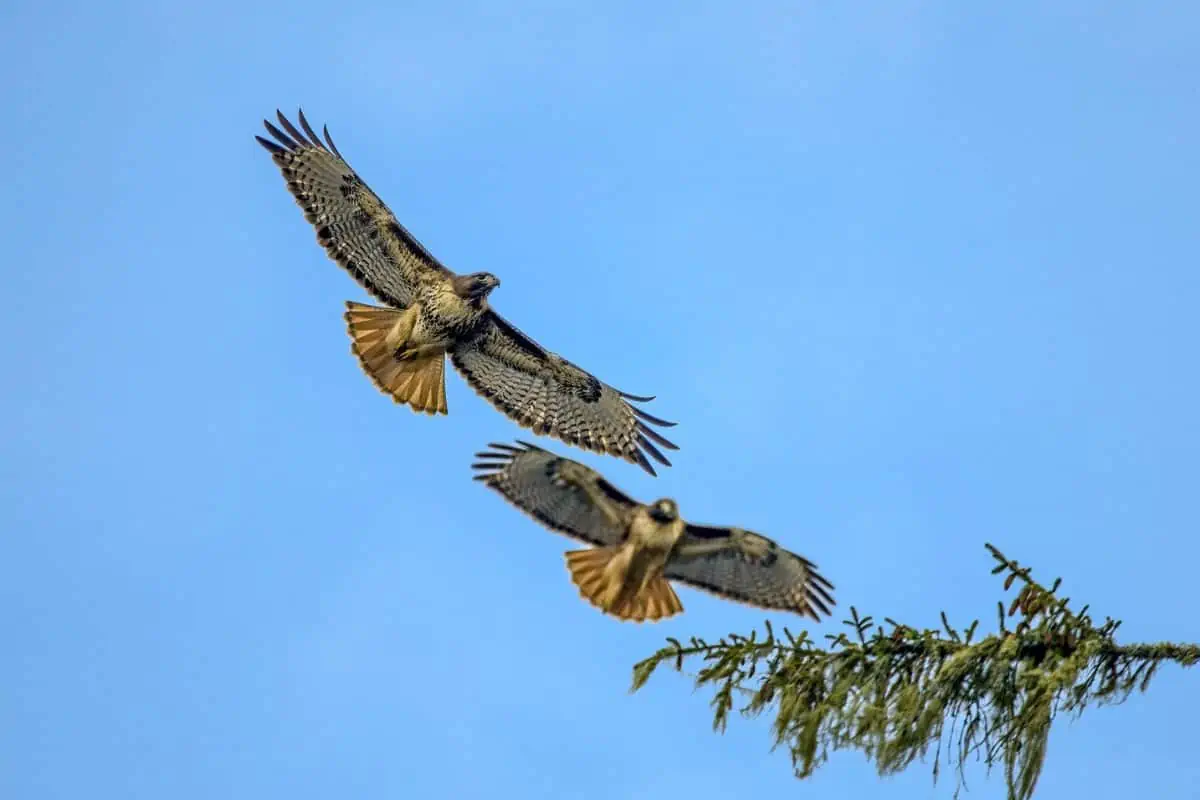Hawks are formidable predators. Their acute hearing and sight, as well as their razor-sharp beak and talons, help them to make excellent birds of prey. Humans have benefited from the hawk’s hunting skills throughout history, via training and falconry. In the United States, there are around 16 different types of hawks. However, the eight types of hawks found in New Jersey will be discussed in this article.
HAWKS IN NEW JERSEY
Broad-winged hawks, Cooper’s hawks, northern goshawks, northern harriers, red-tailed hawks, red-shouldered hawks, rough-legged hawk and sharp-shinned hawk are the eight species of Hawks that may be found in New Jersey.
Let’s take a look at each one.
1. BROAD-WINGED HAWK

Scientific name: Buteo platypterus
Length: 13.4-17.3 in
Weight: 9.3-19.8 oz
Wingspan: 31.9-39.4 in
During the spring-summer breeding season, broad-winged hawks migrate north into New Jersey. The head and breast of these smaller hawks are brown, while the underparts are barred. The tail has black and white bands. Their small tail and wide wings with pointed ends are visible in flight.
During the breeding season, these hawks prefer to be alone. Far from human habitation, they will nest in woods and near watercourses. Little mammals, insects, and amphibians like frogs and toads are among the animals they eat.
Your best opportunity to see the broad-winged hawk is in the autumn when they return to South America from their travels. Thousands of birds circle in the sky in flocks known as “kettles.” You may see them in woods if you’re not in their migration path. Just listen for the whistles, which are piercing.
2. COOPER’S HAWK

Scientific name: Accipiter cooperii
Length: 14.6 – 17.7 in
Weight: 7.8 – 24.0 oz
Wingspan: 24.4-35.4 in
Cooper’s hawks can be found year-round in New Jersey, where they may be found all throughout North America. Adults have a red eye and a squared-off head with a black hat. They have a bluish-gray back and heavy orange barring on the chest. Immature birds have a brown back and head, as well as white underparts with strong brown stripes. They have yellow eyes.
They seem to be quite comfortable in the suburbs, as well as forests and woodlands. Little birds are their primary food, and they hunt them expertly in the tree canopy. The Cooper’s hawk is a common sight in people’s yards, where they have been seen chasing birds at bird feeders, particularly starlings, doves, and pigeons.
Cooper’s hawk skeletons show that many of them had broken bones in their chest, and Cooper crashes through trees and foliage on a high-speed chase after birds, taking his toll.
3. NORTHERN GOSHAWK
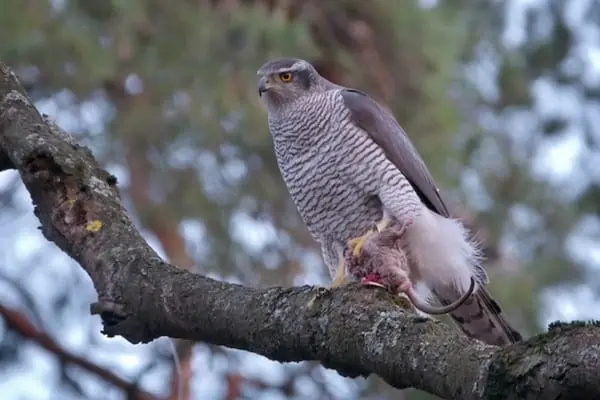
Scientific name: Accipiter gentilis
Length: 20.9-25.2 in
Weight: 22.3-48.1 oz
Wingspan: 40.5-46.1 in
The back and chest of goshawks are gray, with a thick stripe across each eye that extends all the way down the belly. The sharp-shinned and cooper’s hawks are their larger, fiercer cousins. Goshawks, on the other hand, are very elusive and prefer to dwell in the forest rather than in human-populated regions, unlike those common in backyards.
During the winter, New Jersey is home to northern goshawks. But, since they prefer to nest in old-growth forest with thick canopy, you may have a hard time locating one. High Point State Park, Stokes State Forest, and Cape May Point are three places where you may find them.
When humans get too close to their nests, they’ve been known to attack them. Therefore, when looking for these raptors throughout the breeding season, be cautious.
Little hawks, birds, mammals, reptiles, and even insects and carrion make up the northern goshawk’s varied diet. They’re a little rare, and their secretive nature makes it difficult to determine how many there are.
4. NORTHERN HARRIER

Scientific name: Circus hudsonius
Length: 18.1-19.7 in
Weight: 10.6-26.5 oz
Wingspan: 40.2-46.5 in
The face of the northern harrier is almost owl-like in its elegance. This disc-shaped face, which directs sound into the ears of these birds to aid them hunt by sound and sight, works similarly to an owls. The long tail and white patch above the tail are two helpful identifying features. Their wings are held in the shape of a “V” and have a characteristic flying style. These birds are described by the term “majestic.”
This hawk can be found throughout New Jersey year-round, though they may be more prevalent during the winter. marshes, fields, and other wide-open areas are common places to find them.
This hawk creates a platform in dense vegetation, such as reeds, willows, sedges, and cattails, unlike many hawks that nest in trees. Males may have two (or more) partners at once, and the female and her children will be fed by them.
5. RED-TAILED HAWK
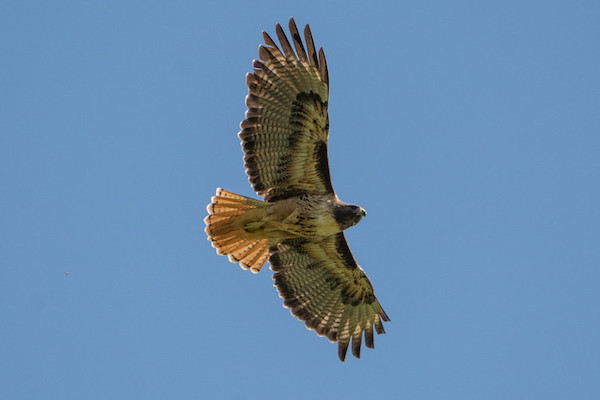
Scientific name: Buteo jamaicensis
Length: 17.7 – 25.6 in
Weight: 24.3oz – 51.5 oz
Wingspan: 44.9-52.4 in
The most frequent hawk seen on the North American continent is the red-tailed hawk, which may be found in practically every state throughout the year. During the winter, when birds that have spent their summer in Canada descend to join the others in the United States, their population grows even more.
Red-tailed hawks are most likely to be observed soaring in pursuit of prey, or perching on telephone poles along the roadway, when they are most active during the day or early morning. Little to medium-sized mammals like mice, rats, rabbits, and squirrels make up the majority of their diet. Birds and snakes are also available to eat.
The tail of an adult is brick-red, making it easy to recognize. The tail of a juvenile, on the other hand, is brown and white striped. These hawks are usually light brown below and dark brown above. Their breast is streaked with brown, and they have a patch of deeper brown streaks across their midsection that’s another helpful distinguishing characteristic. There are various color variations across the country because these hawks are so common.
The long scream of the red-tailed hawk has become a emblem for all raptors. Their cry is nearly frequently utilized as the sound for any hawk or eagle seen on film in films and TV.
6. ROUGH-LEGGED HAWK
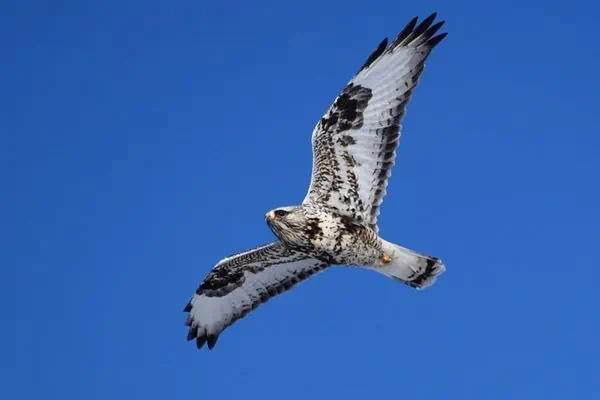
Scientific name: Buteo lagopus
Length: 18.5-20.5 in
Weight: 25.2-49.4 oz
Wingspan: 52.0-54.3 in
Throughout the autumn and winter, rough-legged hawks may be seen in New Jersey, particularly near the shore. They travel all the way to the northern Arctic when it comes time to breed! They’ll build nests on cliffs and rocky outcroppings there.
You’ll see them in the wide-open areas of the United States during the winter, perched on poles and fence posts. Mice, voles, and shrews are all hunted here. The wind-turning rough-legged hawks flap their wings to generate a hover-in-place position from which they can peer the ground below them for prey.
The feathers on the legs of rough-legged hawks give them their name. Feathers that span the length of a raptor’s legs are uncommon in the United States. The majority have a thick black belly patch and are heavily mottled dark brown and white. As the wrist moves against a light backdrop, you’ll notice a dark patch. A dark-morph, which appears two-toned from below and seems almost black, exists as well.
7. SHARP-SHINNED HAWK

Scientific name: Accipiter striatus
Length: 9.4-13.4 in
Weight: 3.1-7.7 oz
Wingspan: 16.9-22.1 in
Sharp-shinned hawks, which stay in New Jersey year-round, are the country’s tiniest hawk. They pursue tiny birds and rodents around the woodland, attacking them.
These are difficult to find while nesting since they prefer forests with thick canopy coverage. They’ll go to feeders in the backyards on occasion to hunt birds. During fall migration, however, is the ideal time to see them. They go south towards the United States. They are seen in huge numbers at hawk watch locations from their summer range in Canada.
Sharp-shinned hawks have a reddish-orange chest and black tail with blue-grey skin on their backs. They also have crimson lines on their breasts. They have a more rounded head and squared-off tail than the cooper’s hawk, which makes them look very similar.
8.RED-SHOULDERED HAWK
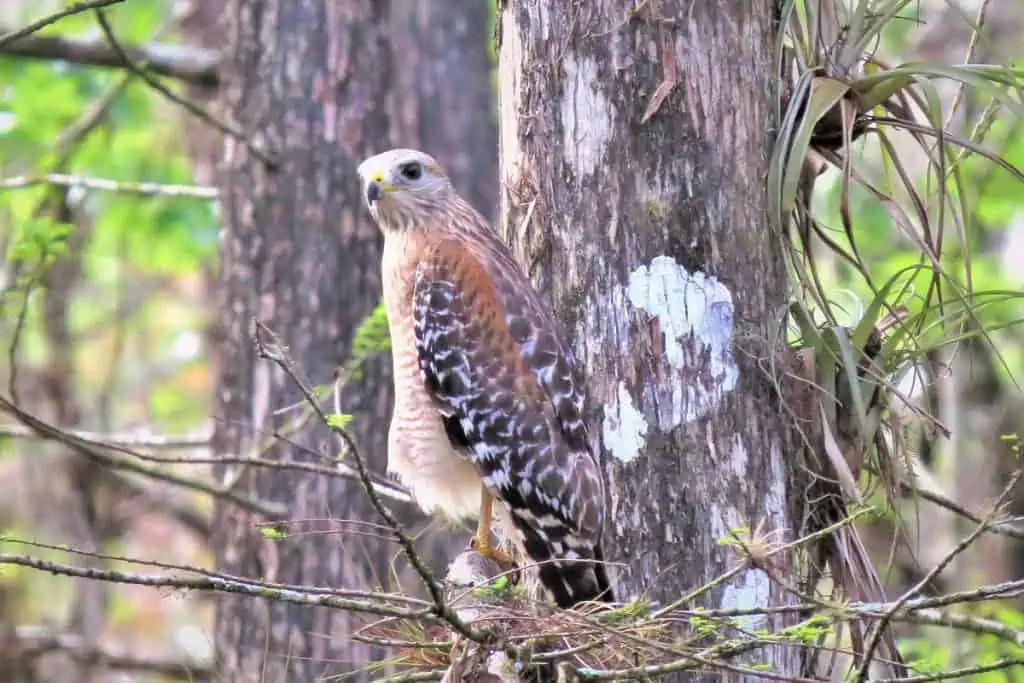
Scientific name: Buteo lineatus
Length: 16.9-24.0 in
Weight: 17.1-27.3 oz
Wingspan: 37.0-43.7
The range of red-shouldered hawks extends across the eastern United States. and the California coast in the west. They are year-round in New Jersey.
The heavy crimson coloring on the breast, which extends down their belly and is bordered by crimson, is a great identifying characteristic. Their backs and wings are covered in dark, nearly black feathers. This will be blended with reddish feathers at the summit of their backs and shoulders (thus their name). There will be a considerable quantity of white barring intermingled with the black feathers from the mid-back to the end of the tail, which is heavily banded.
Before you see it, you may hear this hawk. They emit a powerful “kee-aah” call that is often repeated several times in a row. It has been compared to a seagull by some individuals. When startled, they will scream and yell to establish their territory.
These birds prefer flooded areas and wetlands to live in and search in. Suburban regions with woods blended in with buildings are also home to them. They’re sometimes mistaken with red-tailed hawks, but once you know the differences, it’s easy to tell them apart.
HAWK WATCHING IN NEW JERSEY
Many people gather to watch and count hawks as they travel in huge numbers during the spring and fall hawk migration. Hawk watch places are often high terrain or open fields where you can see the hawks soaring in the sky from a good sight point.
Cape May, New Jersey, is one of the country’s top hawk-viewing spots. During the autumn, when water surrounds both sides of this peninsula, it acts as a funnel for raptors flying south to Cape May. Cape May is also a great place to add new species to your life list, with many other birds traveling through. The Cape May Bird Observatory has a wealth of information available.
